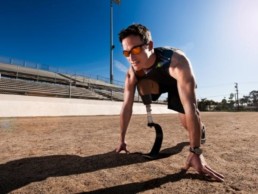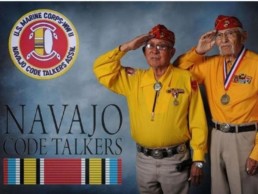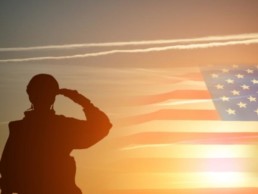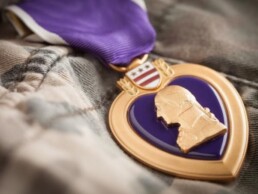Could Golf Help Survivors Suffering from PTSD?
Did you know that when a service member goes through a traumatizing event, likely caused in battle, it can leave behind harrowing mental and emotional scars? What we now know as Post Traumatic Stress Disorder forms as a result and creates problems for our veterans, the most common symptoms are anxiety and depression. Because PTSD is an unseen condition where the symptoms can get worse and affect everyday life, many of our nation’s veterans must find a way to cope and deal with the stress of trauma related PTSD, by finding support. Surprisingly, one good way that helps veterans is through recreational therapy. More specifically, golf.
It’s been proven that a consistent physical regiment can help decrease the impact of PTSD over time. According to one study, “A 12-week exercise program that included three 30-minute resistance training sessions a week, as well as walking, was found to lead to a significant decrease in PTSD symptoms, depression, and better sleep quality after the program ended.”
It was very helpful to learn that veterans can treat PTSD by playing golf because it helps take their mind off things, it brings physical exercise from playing, and they can meet new peers while sharing 18 holes. Remember, golf is a lengthy game and full of competitiveness, making it easy to get distracted from your problems, thus acting like a therapy for PTSD.
For the past six years, many veterans have participated in a joint program with the Purple Heart Service Foundation and the local VA Hospital to participate in the 6th Annual Purple Heart Open as a part of their therapy. Vets take the opportunity to not only relieve stress, but also to talk with other veterans who can relate to their experiences . Matthew Levine, a retired U.S. Army Veteran, says “Golf has been a way to reduce stress and get back to normal.” Another veteran, Ed Afanador, says “It gives you a common ground if you’ve been injured, and you have someone to talk to that has that commonality between each other.”
As the weather is heating up, we hope more veterans will take the opportunity to get outside and get active. The Purple Heart Open may only come once a year, but the golf course will be open all summer long.
Mesothelioma in Veterans: 4 Things to Know
Veterans today are at risk for developing a multitude of illnesses that can range in impact from mild to extreme. Whether it be a physical injury from one incident, or delayed onset symptoms as a result of prolonged exposure to certain hazards, the life of a veteran can be in danger long after they are no longer actively serving. One serious illness that veterans can be at risk of developing is mesothelioma. Here are some things that all veterans should know about this dangerous cancer:
1. Veterans make up 30% of those diagnosed with mesothelioma in the United States.
Mesothelioma is a rare form of cancer caused by the inhalation or ingestion of asbestos fibers. Asbestos is a mineral that can be found in various construction materials, especially in products used prior to the 1970s. Due to its average 10-50 year latency period, mesothelioma does not usually present itself until much later that the asbestos exposure occurs.
While all veterans and active duty service members are at risk for having been exposed to asbestos, you are more likely to have been exposed and develop mesothelioma if you served between the years 1930 and 1980. This is due to the high volume of asbestos products being used and the low restrictions of their use.
There is an even higher correlation between mesothelioma and navy veterans. Asbestos-containing materials are especially common in shipyards and shipbuilding materials, and being in tight spaces can increase the risk of asbestos fiber inhalation. Veterans who served in this branch should be high-alert for mesothelioma symptoms.
2. Mesothelioma can affect more than the lungs.
Mesothelioma is often thought of as only being a type of lung cancer. However, this disease has various types that can impact different parts of the body. Each type of this cancer also comes with a different set of symptoms. The most common form of mesothelioma is pleural mesothelioma, which affects the lining surrounding the lungs. This type of mesothelioma is responsible for about 80-90% of diagnosed cases. Symptoms of pleural mesothelioma might include chest pain, a persistent cough, coughing up blood, shortness of breath, fever, and night sweats.
The next most common form of this cancer is peritoneal, which affects the lining that surrounds your abdominal organs. Peritoneal mesothelioma can include symptoms like abdominal pain and swelling, weight loss, and even blood clotting.
The two other, more rare, types of mesothelioma are pericardial and testicular. Pericardial mesothelioma affects the lining surrounding the heart, and testicular mesothelioma affects the lining around the testicles. Symptoms of mesothelioma in your heart include chest pain and an irregular heartbeat. And for testicular mesothelioma,you might experience testicular pain, scrotal swelling, and you might even notice a mass.
3. Asbestos exposure is possible even after active duty.
While exposure to asbestos might be more likely to occur during active duty, veterans can also be at risk for exposure depending on their career path after serving. Because of skill sets gained from your time in the military, many veterans may choose to follow careers in engineering, construction, or mechanics. These occupations are all at risk for asbestos exposure due to the products used.
You may also be at risk after your years of active service from secondhand asbestos exposure. Secondhand exposure can occur when there are asbestos fibers left on your uniforms or personal belongings, and you end up inhaling or ingesting them. You could also come into contact with someone who is still serving and in the presence of asbestos-containing materials, which could put you at risk.
4. You have resources to help.
If you have suspected symptoms of mesothelioma, it is crucial to visit a doctor. Early diagnosis can be critical in the setup and success of mesothelioma treatment. However, both the treatment for mesothelioma and the illness itself can greatly impact your financial situation and your ability to provide for yourself and your family. Luckily, organizations have recognized this and have implemented ways to help.
The U.S. Department of Veteran Affairs (VA) recognizes illnesses due to asbestos exposure during service and has made financial benefits available for things like expensive treatments and potentially lost wages. Veterans can file a mesothelioma VA claim, or an asbestos-related lung cancer claim, both of which are given a 100% disability rating. The VA can also assist with finding specialized care through VA accredited hospitals.
Life after active duty can be a difficult period of adjustment and you may still feel the impacts of your time in the service for years to come. You can set yourself up for life-long success by arming yourself with as much information as possible and the knowledge that you have help available to you.
4 Ways Veterans Can Take Control Of Their Finances
Taking control of your finances can be trying for anyone, but for struggling veterans, this issue may feel impossible to tackle. Luckily, there are lots of resources available, and the Purple Heart Foundation prides itself on helping military veterans and recognizing the sacrifices they’ve made. We would like to extend some information on how veterans can take control of their own finances on an individual basis.
1. Check Your Credit Score
Credit scores may not be the first thing on your mind when checking your bank accounts, but they are an extremely important tool that is needed when making big-ticket purchases. For example, buying a home will require a credit score check before you are able to take out a loan. Although VA loans offer flexibility to veterans, it’s still a great idea to first understand what credit score is needed to buy a home. Checking your credit score is free and won’t impact your credit. Plus, just this small step will allow you to gain a clearer picture of your financial situation.
2. Have a Plan to Pay Off Your Debts
Anyone struggling with debt understands the burden it can have. However, it’s crucial that big and small debts alike come with a plan for paying them off. Some of the more important factors to consider when creating a debt payoff plan that financial experts recommend is to include what your baseline budget will be and how much you’re going to allocate each month toward your debt payoff. Having an idea of how you’re going to pay your debts on time and eventually living debt free will be a huge weight off your shoulders and allow you more flexibility in your finances.
3. Cancel Unnecessary Subscriptions and Limit Overspending
Overspending is a common problem for many. There’s a reason such a thing as “retail therapy” exists! But that joy from buying a fancy back scratcher will quickly fade once you do the math on how much these unnecessary wants are costing you. Ways to combat emotional spending may include window shopping instead of buying so you can learn to understand what triggers your desire to overspend. Even taking a look at your monthly subscriptions, such as streaming services, and cutting back on those can help you increase your budget and improve your ability to meet long-term financial goals.
4. Save Up Toward Retirement
Lastly, retirement should be a huge consideration and part of your overall financial plan. Whether it’s through a 401(k) plan or savings account, having money set aside specifically for your retirement is a great way to start. Consider also speaking with a financial advisor to see exactly how much you and your family should save up to retire, and what your individual options are.
Taking control of your finances is no small task, and with the COVID-19 pandemic, this task may become that much more difficult. The Purple Heart Foundation is committed to helping veterans in whatever way possible, so we hope these steps will help you take control of your finances. If you would like to help veterans who are struggling financially, please be sure to check out our Veterans Critical Assistance Grant and make a donation today. Together, we can make a difference in the lives of our nation’s veterans.
Paralympics Rio 2016
This year’s Olympic games in Rio de Janiero, Brazil was full of exceeded expectations, excitement, and more. In addition to Simone Biles, Michael Phelps, and other Olympians, there were 19 servicemen and women who qualified for a position on the Team USA roster–15 active-duty personnel, 2 veterans, 1 Navy civilian, and 1 incoming midshipman to the Naval Academy, including Spc. Dan Lowe, Regine Tugade, and 2nd. Lt. Sam Hendricks.
Out of all 121 medals, Army Specialist Paul Chelimo received one of the 37 silver medals awarded. Chelimo, who was born in Kenya, won the silver in the men’s 5,000 meter run. After the race, he was informed by a television reporter that he was disqualified from the race for infringement in another athlete’s lane, but the ruling was later overturned. Chelimo ran his best time of 13 minutes, 3.94 seconds, right behind Great Britain’s Mo Farah.
Chelimo was a part of the U.S. Army World Class Athlete Program, which he credits for being the reason he was able to compete in Rio, “I’m only here because of these Army Soldiers,” Fanning said. “That’s the reason I’m part of this delegation. But it was fun for the entire delegation to have an extra reason to cheer, not just for the United States but for the Army, so they were screaming loudly for him: ‘Who’s your Soldier? Who’s your Soldier?’”
Chelimo’s next tour will not be overseas with fellow soldiers, but throughout the United States as a trainer with the World Class Athlete Program, inspiring the youth in this country to follow their dreams.
With the Olympics at a close, it’s time to turn our attention to the 15th Paralympic Games, which will also be held in Rio. Of the Paralympians competing, there are 20 soldiers, six Marines, three sailors, and one airman across the 23 sports being showcased.
In addition to Brad Synder, a sailor who lost his eyesight in Afghanistan and holds the world record for the blind 100-meter freestyle, there is Anthony McDaniel competing in Para Rugby and Elizabeth Marks, competing in Para Swimming, among other athletes and veterans. McDaniel lost his legs and left hand in 2010 from an improvised explosive device while serving as a Marine in Afghanistan and Marks suffered severe hip injuries while an Army combat medic in Iraq in 2010, which left her with no sensation in her left leg.
McDaniel said back in 2014 that adaptive sports helped give him a sense of tranquility after spending more than a year in rehab following the IED explosion in August 2010, “It’s just been helping me stay focused and positive,” McDaniel said. “It keeps me out and active every day.”
Marks told ESPN that the medals she earns in her competitions are not the end game–to her, the process of competing is more gratifying and thinks back to helping others during her time as a combat medic, “When I step onto the blocks, I never think, ‘I want to win,’” she says. “I think, ‘I want to pour all of myself into this race because there are people who can’t physically, mentally or emotionally, do that.’ So it’s my way of performing for them.”
The Paralympics are now days away from the start of the 15th Paralympics. It runs from September 7-18. We salute these servicemen and women and are excited to see how they compete and represent the United States and their respective military branches.
The Purple Heart Foundation is committed to assisting not just the Veterans of the Paralympics, but all veterans who have served our country. Show your support for these brave men and women by making a one-time or monthly pledge to ensure Veterans continue to get the support and benefits they deserve by clicking here.
From Deployment to Employment: How to Adjust to a Civilian Work Environment
Transitioning from military service to a rewarding career can feel like a daunting undertaking. The work environment and requirements are usually pretty different. What made you successful in the military may not work as well or could even be counterproductive in civilian life.
Many veterans have trouble coping with this adjustment for several reasons:
- The lower stakes lead to boredom.
- The lack of straightforward rules and missions can cause confusion and anxiety.
- Survival behaviors learned during combat, like a flight or fight response, are counter-productive in a work environment.
- Stress and painful memories from deployment can make it difficult to concentrate and remember important information.
- Military skills don’t always translate to a new work environment.
But the structure and discipline you mastered during your military service can also help you succeed in a civilian work environment. Here are a few things to remember:
Focus on your health.
- See a doctor when necessary and only take medications as prescribed.
- Stay away from unhealthy foods (high fat, high sugar).
- Don’t use non-prescribed drugs or drink alcohol excessively.
- Keep a routine—get enough sleep, exercise regularly, eat at the same time each day.
Learn and practice communication skills.
- Maintain polite and friendly communication with co-workers
- Ask for help about talking about deployment with colleagues
- Learn the appropriate ways to handle conflict and criticism, taking into account the culture of your workplace.
Practice organization
- Keep you workspace neat
- Make task lists
- If you have trouble staying focused, write your thoughts in a journal or notebook.
Create your own structure
- Assess your values and make a list.
- Determine the ways your job fits with your values.
- To identify your values, ask yourself questions like:
- What kind of an employee do I want to be? Hard-working? Dependable? A trustworthy officer?
- What parts of work are important to me? Using and building my skills? Fixing problems? Leading a team of people?
- What do I like about my current job? The way people treat each other? The feeling of accomplishment? Good benefits?
- How does this job fit with serving my country?
- Set long-term goals, like an ideal future position or promotion, and then set short-term goals that will help you achieve them.
- Stay current on training and the technology used in your field.
If you are looking for some training, check out Purple Heart’s Veterans Vocational Technical Institute.
If you want to go back to school and complete an undergraduate degree, learn about Purple Heart scholarships.
For career counseling or other services, find a National Service Officer near you.
Resources:
TurboTAP (Transition Assistance Program)
Veterans’ Employment and Training Services
Military.com Veteran Employment Center
Sgt. Dorsey: The wallet that saved my life!
On Aug. 14, 1937, Mrs. Elizabeth Dorsey gave her youngest son, Raymond, a leather wallet as a present on his 16th birthday; she never knew that wallet would save her son’s life in WWII.
Raymond Dorsey joined the 22nd Infantry of the 4th ID a few weeks before Christmas. “We were in the Hürtgen Forest of Germany during the Battle of the Bulge. There was lots of snow, and it was so cold the soldiers had to take socks and other clothing off the dead to keep warm” – these memories still haunt Mr. Dorsey to this day.
“If it wasn’t the Germans trying to kill us it was the weather. I fought through the Bulge until mid-January of ’45 when it was over. This is when the prisoners started turning themselves in – they were glad to be out of it. There were more of them than there were of us, but the fighting was over, and they were surrendering. Middle of Jan ’45 – my outfit started to receive a lot of German prisoners. I had to line them up and search them. They all had a wallet full of German money, which was worthless to them now – there was nothing for them to buy, nowhere they could spend it – but I didn’t have any money. I traded them anything I could give them for their money. I ended up with so much of their money – my wallet was so full I couldn’t carry it in my back pocket, like normal, so I moved it to my shirt front pocket. We took artillery fire during the fighting at the Bulge and up until this time I had several close calls – yet was never hit.
We were later moved to the city of Prüm, Germany, on Feb 14, 1945 – we were told to set up a staging area at the edge of town. The enemy was waiting to hit us until the late evening; dropping shells all around us. We had to set up a command post in a house with two medics setup in the basement. I was on guard duty when the Germans dropped a shell real close. I was a little way away from the house and hadn’t been hit, so after those shells dropped, I moved closer to the house to find some cover. I took one step into the house and when I turned around a shell landed right in front of me… and that’s when my lights went out. The fat leather wallet in my shirt pocket, now over my heart, caught the main hit of shrapnel. I was unconscious and the medics helped save me by stopping the bleeding.
When I came to, I was on the floor of a big building, maybe an airplane hangar. From what I could see, the whole floor was covered with soldiers like myself – just full of soldiers like me. I wanted a drink of water – they wouldn’t give it to me, but they did give me a shot of morphine. I hadn’t had a shave or bath since I’d arrived. I must have been a sight! I don’t know how long I was there or where it was – they kept me knocked out. They loaded me into an ambulance, and I remember I heard them say we were passing the Eiffel Tower, so we must have been in Paris at this time. When I woke up next – I woke up bathed, shaved and in a clean bed with sheets. I don’t know how long I was in France. All I remember next is waking up in a hospital in England and being handed my belongings, the wallet included; only this time it was full of American money – someone had changed all the German money for American! I felt blessed because there was enough money in my wallet to send $100 to my wife (which was a lot of money in 1945) and I kept the rest.
My right thigh was all bandaged up and they started to unwrap it. They later rolled me outside for a long way to the operating room – that’s when they sewed up my leg wound and put it in a cast. When the cast was removed, my doctor came around and asked, “how are you doing today soldier?” I said “well, they just removed my cast, but I can’t move my knee.” He went to the bottom of my bed, grabbed my right foot and gave it a heave – like a pistol shot, you could hear it – but after that I could bend my knee again. I can still see shrapnel in my thigh, my ankle and I’ve got a little in my face around my left eye. My buddies in the hospital though were the ones to point out there was a hole in my wallet, that’s when I realized that the wallet my mother gave me on my 16th birthday is what saved my life that night in Germany!”
Sgt. Dorsey was never able to tell his mom that she had saved his life with her birthday gift. When he was medically fit to be sent home, he learned his mother was terminally ill. Sgt. Dorsey told us “I was able to see my mom just before she passed, as I’d finally been released – she was a good mother. I didn’t talk to her about the war, never showed the wounds; it was too soon, and people didn’t want to know. I still have to live with it.”
Veterans and Purple Heart recipients like Sgt. Dorsey did not only help shape history, they carry their own part of history with them, just waiting to impart their stories, experiences and wisdom on others. The next time you come across a veteran, take a moment to listen and you may be amazed at the incredibly heroic, selfless, and in cases like this…miraculous stories that nobody else knows about. One VA Center nurse took the time to not only listen to her patient, but to send the Purple Heart Foundation a written recount of Sgt. Dorsey’s story to share with all of you! Join us in saluting Mr. Dorsey for his service and sacrifice!
The Purple Heart Foundation provides various programs and assistance that supports our veterans and their families. The Purple Heart Foundation is committed to assisting veterans, and their caregivers, in all aspects of their lives, including helping those who need assistance while transitioning from the battlefield to the home front. You can show your support for these brave men and women who have sacrificed so much for our country by making a one-time or monthly pledge to ensure veterans continue to get the support and benefits they deserve.
Help last “Navajo Code Talkers” This Memorial Day!
After the recent passing of 97 year old Navajo Code Talker, Fleming Begaye Sr., the Navajo Nation will be doing something special to honor the service and sacrifice of their veteran community.
This Memorial Day the Navajo Nation in Rock Point, Arizona will be hosting a Memorial Day Celebration to honor more than 74 veterans, multiple Purple Heart recipients, 2 Gold Star Moms and the last 2 remaining Navajo Code Talkers from World War II, Peter MacDonald and Thomas Begay!
This Navajo community is a small and humble group of Native Americans that live on reservation, so they have partnered with the Purple Heart Desert Thrift Shop in Mesa, Arizona to collect donations until May 24th. 100% of ALL cash donations in store or donations online will benefit the Navajo veterans and their Memorial Day Celebration!
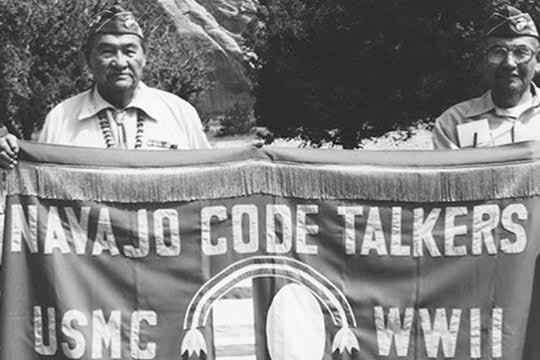
The Navajo Code Talkers have a unique history and are an infamous group of veterans that were recruited by the United States Marine Corps to use their native Navajo language to help maintain communication secrecy during the World War II. After the Navajo Code was developed, the Marine Corps established a Code Talking School where over 400 Navajos (Dine) were recruited as Code Talkers throughout World War II. The Japanese were never able to break these codes, that is why the Navajo Code Talkers are legendary – after WWII they were credited with helping the United States secure the Allied victory in the Pacific.
Navajo Nation President Jonathan Nez and Vice President Myron Lizer offered their heartfelt condolences to the family and loved ones of Navajo Code Talker Fleming Begaye, Sr., who passed away on Friday at the age of 97 in Chinle, Arizona.
“The Navajo Nation has lost another brave and selfless Diné warrior, who sacrificed more than we’ll ever know to defend our country,” said President Nez. “We offer our heartfelt appreciation to the family for sharing his life with us. May the Creator bless you and your family with strength and comfort.”
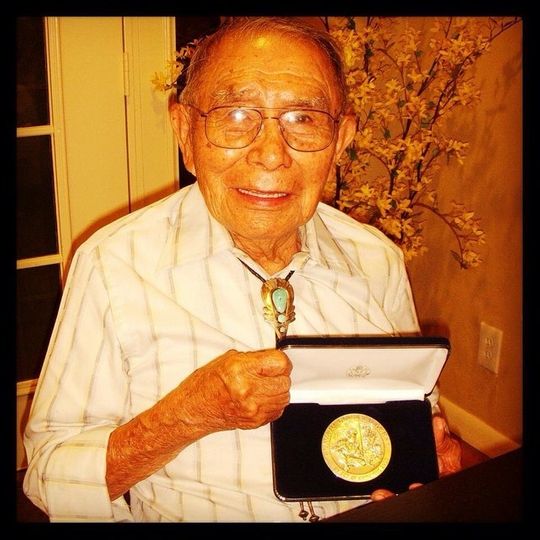
Navajo Code Talker Begaye is Tódích’íi’nii (Bitter Water Clan) and born for Kinłichii’nii (Red House People Clan). He was born on Aug. 26, 1921 in the community of Red Valley, Arizona and resided in Chinle, Arizona at the time of his passing. Begaye served as a Navajo Code Talker in the Marine Corps from 1943 to 1945 and fought in the Battle of Tarawa and the Battle of Tinian. He later spent one year in a naval hospital as a result of injuries and wounds he received during his service.
Following his military service, Begaye returned to the Navajo Nation where he owned and operated “Begaye’s Corner” trading post in the community of Chinle, where he also lived with his wife and three children.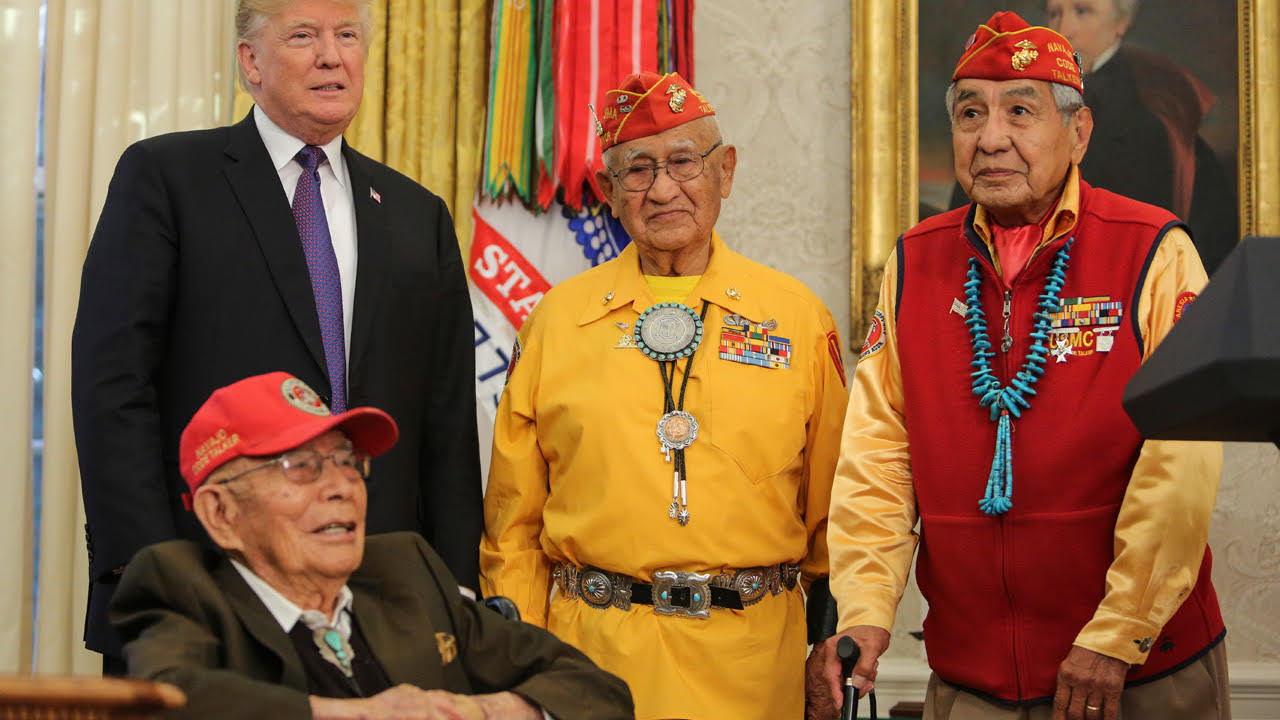
“Code Talker Begaye was a warrior, a family man, and a businessman. In every aspect of his life, he was a loving person who cared greatly for his people. Today, I ask our Diné people to keep his spirit and his family in your prayers as we give thanks for his life and his legacy,” said Vice President Lizer.
Funeral services and arrangements for Navajo Code Talker Fleming Begaye, Sr. are pending.
You can help the Navajo Nation honor Mr. Begaye’s heroic comrades, the last remaining Navajo Code Talkers, Peter MacDonald and Thomas Begay, as well as recognize dozens of other distinguished Navajo veterans and their families living on the Navajo reservation in Arizona….
Make a donation to the Navajo Nation Memorial Day Celebration at Purple Heart Desert Thrift!
100% of your donation will benefit the Navajo veterans and your donation is 100% tax-deductible! Help us honor their service and sacrifice!
JP Lane's Short Story
JP Lane’s Short Story – Purple Heart Veteran
My name is Justin Lane, aka JP Lane. Many people have their own reasoning for joining the military, mine is probably similar to most my age, in 2001, watching the twin towers fall. I was reminded of that feeling when I was old enough to sign up. At the age of 20, In 2008, I joined the U.S. Army as a Combat Engineer. I was deployed, in 2010, to Afghanistan to search for IED’s (Improvised Explosive Devices). I was blown up 3 separate times, and the 3rd one got me. July 2nd, 2011, I was blown up by a 200lb IED while on mission. It was the first IED to penetrate an RG31 truck. The blast resulted in putting me in a coma for 6 weeks. I lost both my legs, right arm snapped in half, lost my four front teeth, pelvis snapped in half, spine dislocated from my pelvis, and everything in my torso was destroyed by shrapnel except for my heart and left lung. In total, I received 26 injuries, and had 28 surgeries, this completely changed my life. Doctors said I wasn’t going to be able to do many things, like, use prosthetics because my legs were so badly damaged. Also, that I wouldn’t be able to speak properly or sing ever again because of a tracheotomy.
With each day, I am proving them wrong. I am the only double amputee recording artist in the world. God wasn’t finished with me yet. Since I got my prosthetics, I have performed for 2 Presidential Inaugurations, Presidents Obama and Trump. I have performed with Lee Greenwood, Neil McCoy, Aaron Tippin, Jason Castro, and more. I have performed for non-profit organizations such as Adopt-a-Vet and Helping a Hero, which are in support of our military. I also, performed for organizations that support the local community, like, “Taking it to the Streets”, a homelessness initiative, and G.A.N.G Outreach in Colorado, that provides positive/encouraging sports camps for underprivileged kids. I have also been able to perform and inspire thousands in Brazil and Mexico. I signed the dotted line when I joined the Army – to SERVE and protect the American people – and since I am still alive, by the grace of God, I will continue to serve. Retirement is just a word! So, I decided to be a motivational speaker to share my story and give hope to those who need it. I am a reminder for others to “Never Give Up, Never Surrender”.
My goal is to impact the world with more than just music. Changing hearts and minds, one at a time.
In a situation like mine, most people would look in the mirror and feel like no one would want them. I was blessed to have found someone who not only loves me for me, but also supports my career and my passion of singing. Crystal, my beautiful wife as of Feb. 2018, has been a huge support for me and given my life purpose. We now work together inspiring couples around us, telling them the amazing story of what brought us together.
April 1st – 9th, I went back to AFGHANISTAN to have a “proper exit.” I was able to visit the hospital I was first recovering in after being blown up. Since I was in a coma, I did not remember much of the hospitals or traveling that I did during that time. As I visited different bases around Afghanistan, I was welcomed back with open arms from thousands of troops. I was proud to walk down the welcome ceremonial row, holding my “NICE TRY TAILBAN” shirt. One of the most amazing feelings was getting to wear the U.S. Army uniform once again, but nothing compared to the feeling of getting to leave the country on my own two feet, prosthetic feet, with my head held high!
Upon returning from Afghanistan, just as it seemed like my story was about to end, Crystal and I were in a serious car accident that rolled our jeep and destroyed our car. Airbags went off in every direction, and glass shattered with every turn of our vehicle. Thank God we were wearing our seat belts, otherwise the damage we received would have been worse. But as part of the strong and determined Lane family, we will overcome. Nothing in this world will defeat us or bring us down! We have a purpose… to bring hope, love, inspiration and the idea of being mentally strong, to people across the world.
Mesothelioma Awareness Day: How This Disease Continues to Impact Veterans
Every 26th of September, Mesothelioma Awareness Day (MAD) is recognized as a day to spread information about this rare disease and educate people about the dangers of its only known cause, asbestos exposure. Of the nearly 3,000 Americans diagnosed with mesothelioma each year, 30 percent of this total are veterans. It is important that we acknowledge the veteran population affected by this disease and continue efforts towards finding a cure.
What is Mesothelioma?
Mesothelioma is a form of cancer that primarily affects the lining of the lungs, but can also be present in the lining of the abdomen and heart. Due to its prolonged latency period, symptoms of this disease typically do not arise for nearly 10 to 50 years. When symptoms do begin to appear, oftentimes, the disease has already progressed to an advanced stage, making treatment options extremely limited.
Historically, the cause of mesothelioma cancer has been linked to asbestos exposure. Asbestos is a naturally occurring mineral that was often used in materials prone to heat and friction. When asbestos is disturbed, airborne fibers have the ability to be inhaled or ingested, gaining access to our internal organs. These fibers lay dormant within our bodies where they cause inflammation and scarring, leading to the development of tumors.
For those diagnosed with mesothelioma, the prognosis is most often very poor. Patients who are diagnosed at an earlier stage are given between 16 to 21 months to live post-diagnosis, which is a limited amount of time to pursue treatment.
How Are Veterans Affected?
Service men and women of our military are susceptible to asbestos exposure as a result of mass historic use of asbestos-products. While there has been a decline in asbestos usage and stricter regulations, asbestos may still be present on military bases, naval ships, and aircraft equipment. Because of this, there is a steady diagnosis rate amongst veterans. This will remain unchanged until asbestos is completely banned in the United States or the government issues a mandate for all asbestos to be removed from military locations.
Those who have served our country between 1920 to 1980 are at the highest risk of developing an asbestos-related disease, as this was the height of asbestos usage. Locations such as the sleeping barracks of ships used in the Navy were tight and limited, allowing for a high concentration of fibers to be present if asbestos was disturbed. Other branches that are affected by asbestos include the Air Force, Army, Coast Guard and Marines through asbestos materials used in things such as aircraft braking systems, military vehicles, and fireproofing for ships.
An additional risk factor that should be kept in mind is the use of asbestos in other countries. Members of our military can also be exposed while on deployment and stationed in areas that are war-torn, and as a result, have created large amounts of debris and rubble.
Across borders, many older buildings and homes on United States bases could be harboring asbestos-containing materials, such as roofing and flooring tiles. While it is difficult to avoid exposure because asbestos fibers are invisible to the naked eye, with the right protective equipment and knowledge, we can work to keep our military safe from these asbestos-related diseases.
Symptoms & Detection
Veterans that believe they may have been exposed to asbestos should receive checkups frequently and monitor their health closely. Symptoms of mesothelioma often mimic those of other less serious illnesses and should be evaluated no matter how seemingly minor. Some of the symptoms are as follows:
- Abdominal swelling
- Breathing difficulties
- Muscle Weakness
- Chest pain
- Coughing
Testing such as X-rays and CT scans can provide insight into underlying symptoms and help identify any abnormalities. Blood tests should also be performed regularly to see if there is an overabundance of mesothelin present in the blood, which may hint at malignancy. It is vital to monitor symptoms immediately. This will allow for the best chance of survival and successful treatment if the disease is caught early.
What to do if You’re Diagnosed
If you are diagnosed with mesothelioma, the next step is to understand your treatment options. It is important to research and connect with an oncologist that specializes in mesothelioma cancer, as they will be able to provide you with the latest and most effective treatments specific to your diagnosis. Cancer treatment costs can oftentimes be burdensome to families, and when diagnosed with mesothelioma, there is typically a party that is liable for the disease that you have developed. To manage these costs better, it is your right to seek legal action, as there are victim compensation funds set in place to ensure those who are affected by asbestos exposure receive the funding they deserve for their treatment.
How You Can Help
Mesothelioma is one of the lesser-known forms of cancer, receiving minimal coverage in mainstream oncology. With the support of others and by spreading awareness, this cancer will not only be diagnosed less, but a cure could be on the horizon. Through donating to the Purple Heart Foundation, the MOPH National Service Officer program will continue to help veterans fight for their VA benefits and receive much-needed care for injuries and illnesses, such as mesothelioma, that stem from service to our country.
Honoring Purple Heart Month
As we begin the month of August, it is our great pleasure to welcome you to
Purple Heart Month!
This month is dedicated to paying our respects to all the brave men and women wounded or killed in combat. The official Purple Heart Day is observed on the 7th day of August each year, commemorating the historic day in 1782 that General George Washington, Commander-In-Chief of the Continental Army, commissioned the first Purple Heart Medal, originally called the Badge of Military Merit.
The Badge of Military Merit is a purple, heart-shaped piece of silk bound with a thin edge of silver with the word merit embroidered in silver across the face. Only 3 Badges of Military Merit were awarded. The Badge of Military Merit was redesigned and re-commissioned in 1932 by General Douglas McArthur in honor of George Washington’s bicentennial birthday. Now known as the Purple Heart Medal – it is the oldest military award, first being awarded to soldiers in World War I and still given to soldiers today.
A presidential order signed in 1942 permitted the Purple Heart Medal to be awarded to all branches of the military including the U.S. Coast Guard. It was World War II, when the qualification to receive the Purple Heart Medal changed to honor those who were wounded or killed in combat – that is why it’s recipients often call it “the medal that nobody wants”. It is unknown how many soldiers actually received it. However, we know that the soldiers listed below are some of the most awarded Purple Heart Recipients in history:
Robert T. Frederick, U.S. Army: World War II (8)
David H. Hackworth, U.S. Army: Korean War (3), Vietnam War (5)
Joe Hooper, U.S. Army, Medal of Honor: Vietnam War (8)
Robert L. Howard, U.S. Army, Medal of Honor: Vietnam War (8)
William Waugh, U.S. Army: Vietnam War (8)
It took the Purple Heart medal many years to evolve into what it is today. Today, on the reverse of the medal, “FOR MILITARY MERIT” is inscribed. The medal itself is made of brass with a gold color to it, and also contains a bust of George Washington and his coat of arms. The purple color represents the blood of all those who have made sacrifices in war, but traditionally it represent the courage of those who serve. The original color of the medal George Washington created was purple, so it was only fitting that it would be used to honor his memory in the new medal.
The Military Order of the Purple Heart (MOPH) was formed in 1932. It is composed exclusively of men and women who have received the Purple Heart Medal and is the only Veteran’s Service Organization whose membership is comprised solely of “combat-wounded veterans”.
The Military Order of the Purple Heart Service Foundation, also known as the Purple Heart Foundation, was later created in 1957 as a non-profit organization. For more than 60 years, the Purple Heart Foundation has solely dedicated itself to funding programs and services that support our nation’s heroes. Donate to show your support of the Purple Heart Foundation and to help us continue to serve our nation’s veterans who have already sacrificed so much.
DONATE




